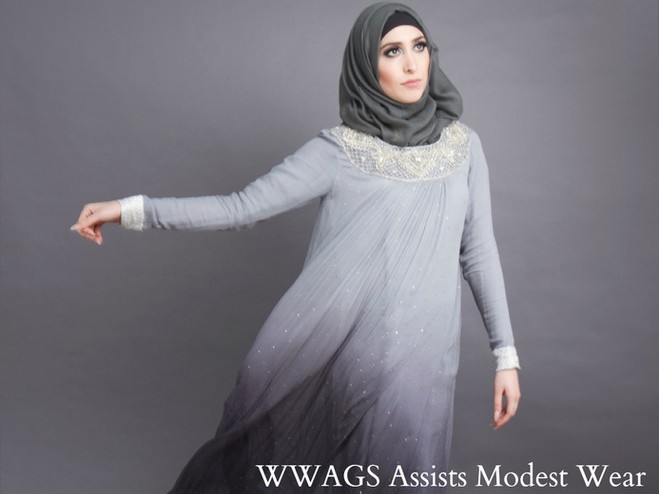After a brief, identity-driven swell in the number of hijab wearers, there now appears to be a decline. Why did women who spent years, or decades, in hijab decide to dehijabize? What is it that women feel must be fulfilled in life without the hijab that is apparently missing while wearing it?
The headscarf was once viewed as a sign of rebellion. Western women fought for their liberation by removing confining corsets and diminishing the amount of cloth clad to their bodies in public: in short, declaring their sexuality to the masses, and inviting their approval. In clear contradistinction to the excessive glitz women are subjected to by the modern fashion, make-up and nip/tuck industry, the modern Muslim woman concealed her sexuality in public, and allowed it to flourish in private. Now, it seems a new rebellion is taking place.
Aqsa Parvez was a young, Asian-Canadian teenager was brutally murdered by her family in late 2007 for removing her headscarf (hijab). Her death remains shocking as honour killings were previously unrelated to the headscarf, but also because it was yet more evidence to show a serious desire held by hundreds of women around the world to remove their headscarves.
I moved to Egypt in 2000, as the country was going through an ‘Islamic awakening’. Left, right and centre, I saw women donning headscarves seemingly overnight – usually after listening to a lesson by Amr Khaled – the now world famous Muslim televangelist – or someone similar. Others went much further. I remember my shock when someone I knew revolutionized her wardrobe within 24 hours; gone were the low-cut tops, the glitter-clad tight-fitting hipster jeans, and knee high red suede boots. In their place: long flowing black cloaks or abayas.
For the following nine years, I lived, worked and traveled in Africa, South-East Asia, the Middle East, Europe and North America. In the midst of my travels, I noticed a startling phenomenon in the past 3 years: the removal of the cloth, once so adorningly clung to by Muslim women world wide – what I like to call “dehijabization”.
A small piece of evidence; Facebook profile pictures of girls in hijab are increasingly replaced; sometimes, the replacement picture is as simple as a woman in loose clothes with her long, flowing hair showing, while at other times it is women posing in bikinis or mini-skirts. Women all over the world are casting off the hijab.
The question remains: Why? Why did women who spent years, or decades, in hijab decide to dehijabize? What is it that women feel must be fulfilled in life without the hijab that is apparently missing while wearing it?
I decided to ask around. Some women had originally decided to wear the hijab to counteract serious sins they had committed in the past. Ironically, some women also removed the hijab because they felt that they were sinners, and were therefore unable to live up to what they felt should symbolize a woman in a hijab. A huge number of women noted that even the most religious of Muslim men were proposing to women who were not in hijab, leaving the women in hijab feeling rather inadequate; if a religious man is uninterested in a woman in a headscarf, who will be?
Many others grew exhausted of the ‘out-of-place’ feeling they had- either because they were in a majority non-Muslim country, where the hijab was viewed as dehumanizing, or because they were in a Muslim majority country which, as a consequence of Westernisation, increasingly viewed the hijab as ‘unsophisticated’ or a sign of poor education.
Yale University anthropologist Carolyn Rouse noted the hijabization phenomenon in 2004 in her book “Engaged Surrender” as one that was about identity, rather than spirituality. Post 9-11, many women felt the need to show their solidarity and oneness with the Muslim ummah. Donning of the hijab – formerly a spiritual act – achieved that political end.
With that kind of ‘Muslim uniform’ in the 21st century comes a sad if unintentional reality – the individual Muslim woman is simply aggregated into one big, undifferentiated lump, leaving her just as objectified as the “sexually liberated” non-Muslim Western woman. Many, whether in the West or in the Muslim world, choose to give her uneasy glares and glances, while boxing her as an “oppressed woman”, who has the inability to do anything unless it is explicitly related to Islam.
The flip side of the coin is that because of the same obsession with the cloth and not its meaning, Muslims in general will demand that any Muslim woman in a hijab not simply be Muslim, but morph into an infallible angel. In this regard, the blame falls much more on the Muslim than the non-Muslim, for the Muslim should know that nowhere in the Islamic tradition is the hijab a sign of perfect character. Rather, it is the fulfillment of an Islamic duty – just like many others.
In truth, it is these Muslims who I suspect bear much of blame for the dehijabization phenomenon. There is much fear mongering instilled by many present day Muslim preachers, who have somehow made the hijab tantamount with faith itself and told to prepare for an eternity in hell if living without it. Yet, where in any of the books written by of the learned scholars of this religion is there any mentioning of the hijab as one of the kaba’ir, or major sins? A sin it may be, to be sure – but is it so dire? Perhaps it is, but the Prophets, the Messengers and the scholars of this religion emphasized it much less than other duties and responsibilities. Yet, modern day preachers will emphasize it more than they will anything else.
But this brings me to the most important point of dehijabization. Women who remove the headscarf because they choose to interpret the Islamic tradition in their own way without training; they are just as problematic as these preachers. Perhaps this is the most alarming and now widespread reason for dehijabization – women who claim that the hijab is not fard (obligatory). This was cited as the most common reason used by the majority of women I have come across who have dehijabized.
Islamic law comes down to 4 things: The Qura’n, the sunna, ijma’a (consensus), and qiyas (logical judgement). Islamic law crystallized around the interpretations of experts over many centuries: those that are now extant and most common are the 4 Sunni schools of law. For centuries, scholars have learnt Islamic law through those interpretative deductions; all these 4 schools came directly from Prophetic teachings and are upheld with their own particular interpretations all over the world. People in Egypt may not realize, but they pray in accordance to the Shafi’i madhab, while those in India follow the Hanafi interpretation of prayer.
For someone who has not dedicated their life to the study of Islam to declare that they have the same ability to interpret the Qur’an as the erstwhile amateur, comes across to me as incredibly arrogant, even while they may not realize their obvious arrogance.
Yes, there are several different interpretations, but they all must come from the basis of Islamic law. But on the hijab, there is no difference of opinion. The 31st verse of the 24th chapter of the Qur’an mentions the word khimar, which unequivocally means a veil covering the head, according to the agreed upon definition by the majority of classical commentators. The commentators (mufasiroon) further comment by stating that the noun khimar (the singular of khumur) was a loosely worn veil which was worn long before the advent of Islam and long after.
However, during the period of the revelation, it was customary that women bared their breasts while covering their hair. In fact, as Arab men went off to battle, women used to bear their breasts to encourage them to be brave; in some cases, they would show their breasts during warfare. With the advent of Islam, until now, Muslim women have been showing only their hands and faces, in accordance with the prescriptions of the Prophet, and the passing of his prescriptions from that time until this day. That methodology is followed not just in terms of the hijab, an admittedly small piece of cloth, but in the whole of this religion.
It’s irrelevant what I, as an author, do or not do vis-à-vis the issue I write about. But on a personal note, I do happen to wear a hijab, in awareness of my duty. Like most women, I often think to myself that men should learn to control themselves, and how perhaps if they did, women would not be obliged to conceal their sexuality in public, and dress any way we would like. But in the final analysis, God has a hikma or a wisdom as to why He created men this way, and why He asked women to cover themselves – He Knows best and He is All-Knowing.
Darah M. Rateb is the Managing Consultant of the Visionary Consultants Group, a Muslim world – West relations research consultancy with bases in the UK, Egypt and Malaysia






1 Comment